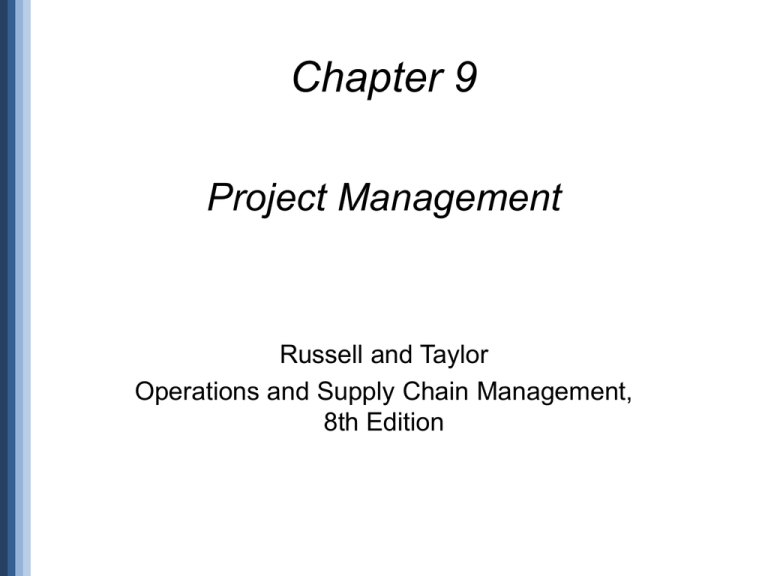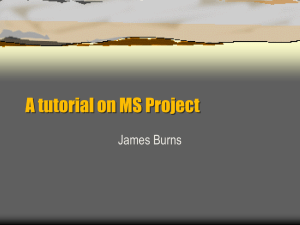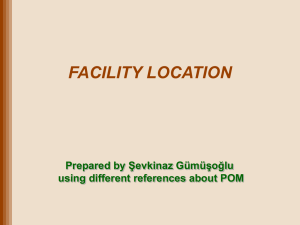
Chapter 9
Project Management
Russell and Taylor
Operations and Supply Chain Management,
8th Edition
Lecture Outline
•
•
•
•
•
•
•
Project Planning – Slide 5
Project Scheduling – Slide 18
Project Control – Slide 21
CPM/PERT – Slide 22
Probabilistic Activity Times – Slide 34
Microsoft Project – Slide 46
Project Crashing and Time-Cost Trade-off – Slide 56
© 2014 John Wiley & Sons, Inc. - Russell and Taylor 8e
9-2
Learning Objectives
• Discuss the project planning process, including planning
tools, evaluation methods, and key elements
• Discuss the benefits of and strategies for dealing with
diverse project groups
• Explain the basics of project scheduling and the use of
Gantt charts
• Define enterprise project management and discuss the
key elements in project control
© 2014 John Wiley & Sons, Inc. - Russell and Taylor 8e
9-3
Learning Objectives
• Define enterprise project management and discuss the
key elements in project control
• Develop and analyze both deterministic probabilistic and
project networks
• Use Microsoft Project for network analysis
• Determine and explain project crashing and time-cost
tradeoffs
© 2014 John Wiley & Sons, Inc. - Russell and Taylor 8e
9-4
Project Planning
• Project
•
•
•
•
•
has unique purpose
not repetitive
relatively short period of time
one-time operational activity or effort
draws resources from multiple departments
© 2014 John Wiley & Sons, Inc. - Russell and Taylor 8e
9-5
Project Management Process
© 2014 John Wiley & Sons, Inc. - Russell and Taylor 8e
9-6
Project Management Process
© 2014 John Wiley & Sons, Inc. - Russell and Taylor 8e
9-7
Project Management Process
© 2014 John Wiley & Sons, Inc. - Russell and Taylor 8e
9-8
Elements of a Project Plan
•
•
•
•
•
•
•
•
Objective
Scope
Contract requirements
Schedules
Resources
Personnel
Control
Risk and problem analysis
© 2014 John Wiley & Sons, Inc. - Russell and Taylor 8e
9-9
Project Return
•
•
•
•
Project requires positive gain or benefit
ROI is one measure, but not always applicable
“Soft” returns
Projects for public good
(Gain from project – cost of project)
ROI =
Cost of project
© 2014 John Wiley & Sons, Inc. - Russell and Taylor 8e
9-10
Project Team and Project Manager
• Project team
• made up of individuals from various areas and
departments within a company
• Matrix organization
• a team structure with members from functional
areas, depending on skills required
• Project manager
• most important member of project team
© 2014 John Wiley & Sons, Inc. - Russell and Taylor 8e
9-11
Scope Statement
• Scope statement
• a document that provides an understanding,
justification, and expected result of a project
• Statement of work
• written description of objectives of a project
© 2014 John Wiley & Sons, Inc. - Russell and Taylor 8e
9-12
Work Breakdown Structure
• Organizes the work in a project
• Breaks project into components,
subcomponents, activities, and tasks
• Start at the top and work down
• Brainstorm project activities
© 2014 John Wiley & Sons, Inc. - Russell and Taylor 8e
9-13
Work Breakdown Structure for Computer Order
Processing System Project
© 2014 John Wiley & Sons, Inc. - Russell and Taylor 8e
9-14
Responsibility Assignment Matrix
• Organizational Breakdown Structure (OBS)
• a chart that shows which organizational units are
responsible for work items
• Responsibility Assignment Matrix (RAM)
• shows who is responsible for the work in a project
© 2014 John Wiley & Sons, Inc. - Russell and Taylor 8e
9-15
Responsibility Assignment Matrix
© 2014 John Wiley & Sons, Inc. - Russell and Taylor 8e
9-16
Global Cultural and Diversity Issues in
Project Management
• Global project teams are formed from different
genders, cultures, ethnicities, etc.
• Diversity among team members can add an
extra dimension to project planning
• Cultural research and communication are
important elements in the planning process
© 2014 John Wiley & Sons, Inc. - Russell and Taylor 8e
9-17
Project Scheduling
• Steps
–
–
–
–
Define activities
Sequence activities
Estimate time
Develop schedule
© 2014 John Wiley & Sons, Inc. - Russell and Taylor 8e
• Techniques
– Gantt chart
– CPM/PERT
• Software
– Microsoft Project
9-18
Gantt Chart
•
•
•
•
•
•
Graph or bar chart
Bars represent the time for each task
Bars also indicate status of tasks
Provides visual display of project schedule
Shows precedence – sequence of tasks
Slack
– amount of time an activity can be delayed without
delaying the project
© 2014 John Wiley & Sons, Inc. - Russell and Taylor 8e
9-19
A Gantt Chart
© 2014 John Wiley & Sons, Inc. - Russell and Taylor 8e
9-20
Project Control
•
•
•
•
•
•
Time management
Cost management
Quality management
Performance management
Communication
Enterprise project management
© 2014 John Wiley & Sons, Inc. - Russell and Taylor 8e
9-21
CPM/PERT
• Critical Path Method (CPM)
• DuPont & Remington-Rand
• Deterministic task times
• Activity-on-node network construction
• Project Evaluation and Review Technique (PERT)
• US Navy and Booz, Allen & Hamilton
• Probabilistic task time estimates
• Activity-on-arrow network construction
© 2014 John Wiley & Sons, Inc. - Russell and Taylor 8e
9-22
Project Network
• Activity-on-node (AON)
– nodes represent activities
– arrows show precedence
relationships
• Activity-on-arrow (AOA)
– arrows represent activities
– nodes are events for
points in time
• Event
– completion or beginning
of an activity in a project
© 2014 John Wiley & Sons, Inc. - Russell and Taylor 8e
9-23
AOA Project Network for a House
© 2014 John Wiley & Sons, Inc. - Russell and Taylor 8e
9-24
Concurrent Activities
• Dummy activity
• two or more activities cannot share same start and
end nodes
• add dummy activity to show correct precedence
© 2014 John Wiley & Sons, Inc. - Russell and Taylor 8e
9-25
AON Network for House Building
Project
© 2014 John Wiley & Sons, Inc. - Russell and Taylor 8e
9-26
Activity Start Times
A:
B:
C:
D:
1-2-4-7
3 + 2 + 3 + 1 = 9 months
1-2-5-6-7
3 + 2 + 1 + 1 + 1 = 8 months
1-3-4-7
3 + 1 + 3 + 1 = 8 months
1-3-5-6-7
3 + 1 + 1 + 1 + 1 = 7 months
© 2014 John Wiley & Sons, Inc. - Russell and Taylor 8e
Critical path
• Longest path through a
network
• Minimum project completion
time
9-27
Activity Scheduling
• Earliest start time (ES)
• earliest time an activity can start
• ES = maximum EF of immediate predecessors
• Forward pass
• starts at beginning of CPM/PERT network to determine
earliest activity times
• Earliest finish time (EF)
• earliest time an activity can finish
• earliest start time plus activity time
• EF= ES + t
© 2014 John Wiley & Sons, Inc. - Russell and Taylor 8e
9-28
Node Configuration
© 2014 John Wiley & Sons, Inc. - Russell and Taylor 8e
9-29
Earliest Activity Start and Finish Times
© 2014 John Wiley & Sons, Inc. - Russell and Taylor 8e
9-30
Activity Scheduling
• Latest start time (LS)
• Latest time an activity can start without delaying critical
path time
• LS= LF - t
• Latest finish time (LF)
• latest time an activity can be completed without delaying
critical path time
• LF = minimum LS of immediate predecessors
• Backward pass
• Determines latest activity times by starting at the end of
CPM/PERT network and working forward
© 2014 John Wiley & Sons, Inc. - Russell and Taylor 8e
9-31
Latest Activity Start and Finish Times
© 2014 John Wiley & Sons, Inc. - Russell and Taylor 8e
9-32
Activity Slack
Activity
LS
ES
LF
EF
Slack S
*1
0
0
3
3
0
*2
3
3
5
5
0
3
4
3
5
4
1
*4
5
5
8
8
0
5
6
5
7
6
1
6
7
6
8
7
1
*7
8
8
9
9
0
* Critical Path
© 2014 John Wiley & Sons, Inc. - Russell and Taylor 8e
9-33
Probabilistic Activity Times
• Beta distribution
• probability distribution traditionally used in CPM/PERT
Mean (expected time):
Variance:
a + 4m + b
t=
6
b-a
= 6
2
2
where
a = optimistic estimate
m = most likely time estimate
b = pessimistic time estimate
© 2014 John Wiley & Sons, Inc. - Russell and Taylor 8e
9-34
Examples of the Beta Distribution
© 2014 John Wiley & Sons, Inc. - Russell and Taylor 8e
9-35
Project with Probabilistic Time
Estimates
© 2014 John Wiley & Sons, Inc. - Russell and Taylor 8e
9-36
Activity Time Estimates
TIME ESTIMATES (WKS)
ACTIVITY
1
2
3
4
5
6
7
8
9
10
11
MEAN TIME
VARIANCE
a
m
b
t
б2
6
3
1
2
2
3
2
3
2
1
1
8
6
3
4
3
4
2
7
4
4
10
10
9
5
12
4
5
2
11
6
7
13
8
6
3
5
3
4
2
7
4
4
9
0.44
1.00
0.44
2.78
0.11
0.11
0.00
1.78
0.44
1.00
4.00
© 2014 John Wiley & Sons, Inc. - Russell and Taylor 8e
9-37
Activity Early, Late Times & Slack
ACTIVITY
1
2
3
4
5
6
7
8
9
10
11
t
б
ES
EF
LS
LF
S
8
6
3
5
3
4
2
7
4
4
9
0.44
1.00
0.44
2.78
0.11
0.11
0.00
1.78
0.44
1.00
4.00
0
0
0
8
6
3
3
9
9
13
16
8
6
3
13
9
7
5
16
13
17
25
1
0
2
16
6
5
14
9
12
21
16
9
6
5
21
9
9
16
16
16
25
25
1
0
2
8
0
2
11
0
3
8
0
© 2014 John Wiley & Sons, Inc. - Russell and Taylor 8e
9-38
Earliest, Latest Times, and Slack
© 2014 John Wiley & Sons, Inc. - Russell and Taylor 8e
9-39
Total Project Variance
2 = б22 + б52 + б82 + б112
= 1.00 + 0.11 + 1.78 + 4.00
= 6.89 weeks
© 2014 John Wiley & Sons, Inc. - Russell and Taylor 8e
9-40
CPM/PERT With OM Tools
© 2014 John Wiley & Sons, Inc. - Russell and Taylor 8e
9-41
Probabilistic Network Analysis
Determine probability that project is
completed within specified time
Z=
where
=
=
x=
Z=
x-
tp = project mean time
project standard deviation
proposed project time
number of standard deviations that
x is from the mean
© 2014 John Wiley & Sons, Inc. - Russell and Taylor 8e
9-42
Normal Distribution of Project Time
© 2014 John Wiley & Sons, Inc. - Russell and Taylor 8e
9-43
Southern Textile – 30 weeks
2 = 6.89 weeks
=
6.89
= 2.62 weeks
Z=
=
x-
30 - 25
2.62
= 1.91
From Table A.1, (appendix A) a Z score of 1.91 corresponds
to a probability of 0.4719.
Thus P(30) = 0.4719 + 0.5000 = 0.9719
© 2014 John Wiley & Sons, Inc. - Russell and Taylor 8e
9-44
Southern Textile – 22 weeks
2 = 6.89 weeks
=
6.89
= 2.62 weeks
Z=
=
x-
22 - 25
2.62
= -1.14
From Table A.1, (appendix A) a Z score of 1.14
corresponds to a probability of 0.3729.
Thus P(22) = 0.5000 - 0.3729 = 0.1271
© 2014 John Wiley & Sons, Inc. - Russell and Taylor 8e
9-45
Microsoft Project
• Popular software package for project
management and CPM/PERT analysis
• Relatively easy to use
• House-building example
© 2014 John Wiley & Sons, Inc. - Russell and Taylor 8e
9-46
Microsoft Project
Click on “Tasks”
First step;
Start Date
© 2014 John Wiley & Sons, Inc. - Russell and Taylor 8e
9-47
Microsoft Project
© 2014 John Wiley & Sons, Inc. - Russell and Taylor 8e
9-48
Microsoft Project
© 2014 John Wiley & Sons, Inc. - Russell and Taylor 8e
9-49
Microsoft Project – Zoom View
© 2014 John Wiley & Sons, Inc. - Russell and Taylor 8e
9-50
PERT Analysis with Microsoft Project
© 2014 John Wiley & Sons, Inc. - Russell and Taylor 8e
9-51
PERT Analysis with Microsoft Project
© 2014 John Wiley & Sons, Inc. - Russell and Taylor 8e
9-52
PERT Analysis with Microsoft Project
© 2014 John Wiley & Sons, Inc. - Russell and Taylor 8e
9-53
Project Crashing
• Crashing
• reducing project time by expending additional resources
• Crash time
• an amount of time an activity is reduced
• Crash cost
• cost of reducing activity time
• Goal
• reduce project duration at minimum cost
© 2014 John Wiley & Sons, Inc. - Russell and Taylor 8e
9-54
Normal Time and Cost
vs. Crash Time and Cost
$7,000 –
$6,000 –
Crash cost
$5,000 –
Crashed activity
Slope = crash cost per week
$4,000 –
$3,000 –
$2,000 –
Normal activity
Normal cost
$1,000 –
Normal time
Crash time
–
0
|
2
|
4
© 2014 John Wiley & Sons, Inc. - Russell and Taylor 8e
|
6
|
8
|
10
|
12
|
14
Weeks
9-55
Project Network – Building a House
© 2014 John Wiley & Sons, Inc. - Russell and Taylor 8e
9-56
Project Crashing
ACTIVITY
1
2
3
4
5
6
7
NORMAL
TIME
(WEEKS)
CRASH
TIME
(WEEKS)
NORMAL
COST
12
8
4
12
4
4
4
7
5
3
9
1
1
3
$3,000
2,000
4,000
50,000
500
500
15,000
$5,000
3,500
7,000
71,000
1,100
1,100
22,000
$75,000
$110,700
© 2014 John Wiley & Sons, Inc. - Russell and Taylor 8e
CRASH
COST
TOTAL
ALLOWABLE
CRASH TIME
(WEEKS)
5
3
1
3
3
3
1
CRASH
COST PER
WEEK
$400
500
3,000
7,000
200
200
7,000
9-57
Weekly Crash Costs – Fig 9-16a
© 2014 John Wiley & Sons, Inc. - Russell and Taylor 8e
9-58
Project Crashed to 31 Weeks
Fig 9-16b
© 2014 John Wiley & Sons, Inc. - Russell and Taylor 8e
9-59
Time-Cost Relationship
• Crashing costs increase as project duration
decreases
• Indirect costs increase as project duration
increases
• Reduce project length as long as crashing costs
are less than indirect costs
© 2014 John Wiley & Sons, Inc. - Russell and Taylor 8e
9-60
Time-Cost Tradeoff
Minimum cost = optimal project time
Total project cost
Cost ($)
Indirect cost
Direct cost
Crashing
Time
Project duration
© 2014 John Wiley & Sons, Inc. - Russell and Taylor 8e
9-61
Copyright 2014 John Wiley & Sons, Inc.
All rights reserved. Reproduction or translation of this
work beyond that permitted in section 117 of the 1976
United States Copyright Act without express permission
of the copyright owner is unlawful. Request for further
information should be addressed to the Permission
Department, John Wiley & Sons, Inc. The purchaser
may make back-up copies for his/her own use only and
not for distribution or resale. The Publisher assumes no
responsibility for errors, omissions, or damages caused
by the use of these programs or from the use of the
information herein.
© 2014 John Wiley & Sons, Inc. - Russell and Taylor 8e
6-62









